Here are a few of my favorite sailboats.
I wouldn't cruise the seven seas in all of them or enter all of
them in the Chicago/Mackinaw sailboat race. They each have their
good points (and bad points). Don't forget, my opinion on these
boats is just that, my own opinion.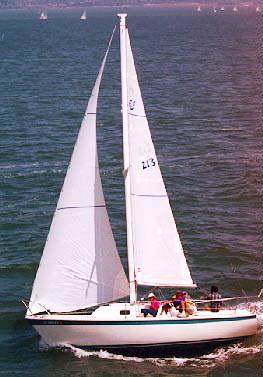 I wouldn't sail
around the world in a Catalina 27 but many sailors have. At least
one person has actually singlehanded a Catalina 27 around the
world. My reply to this: "several people have gone over Niagara
Falls in a barrel but I'm not going to do it." That same person
that went over the falls in a barrel will probably single hand a Catalina 27 around the world.
I place the comfort rate in both about the same. Actually, here in the Great Lakes,
I enjoy a 27 foot sailboat.
I wouldn't sail
around the world in a Catalina 27 but many sailors have. At least
one person has actually singlehanded a Catalina 27 around the
world. My reply to this: "several people have gone over Niagara
Falls in a barrel but I'm not going to do it." That same person
that went over the falls in a barrel will probably single hand a Catalina 27 around the world.
I place the comfort rate in both about the same. Actually, here in the Great Lakes,
I enjoy a 27 foot sailboat.
Photo at right is a Cal 2-27, full and by, going to
windward on a port tack. My Cal put the fun back into sailing for
me. I'm pleased with the way my Cal 2-27 "imp" sails. I was afraid
that I would be disappointed with anything smaller than my Citation
34 but instead, find that sailing the Cal is a pleasure after the
Irwin 34. If you're a Cal fan, as I am, please go back to our "Main
Index Page" and visit my "Homepage for older Cal Yachts sailors".
(Available after 2/15/98). See specs for this Cal 2-27 further down
on this webpage...
9/15/2014: As you probably can see by looking
over my website, two of my favorite sailboat designers
are Bill Lapworth and Robert Perry. Bill Lapworth
designed most of the Cal Yachts, including the Cal 40.
Bob Perry's most famous design was the Valiant 40, a
very popular fin keel, canoe stern sailboat. Bob
Perry does reviews on sailboats every month in "Sailing"
magazine. He has included these reviews in six books,
"Sailing Designs" volumes 1 thru 6. Mr. Perry has
reviewed over 1100 sailboats in these six volumes. I
have purchased all six volumes, read them every day. His
reviews are extremely informative. The problem is:
Which reviews are in which volume? .I've listed
the 1,113 sailboats, the volume they're in, and a few
notes on many of the boats listed. they're in my MS
Excel 2010 file (YachtDesignsPerry.xlsx). If you
would like a copy of this file just send me an email.
go2erie@sssnet.com
I've owned a couple of 27s and sailed them thousands of
miles here on Lake Erie and Lake Huron. I owned a 1974 Catalina 27 for about 10
years, traded it for a new Irwin Citation 34 (my first and only new boat), and
now sail a 1974 Cal 2-27.
Listed below are specs, line drawings and my opinions on:
Carl Alberg's designs, Pearson 30, Crealock 34,
Irwin Citation 34, Bruce Roberts 34, Crealock 37, Catalina 27, Cal
2-27, Catalina 30, Bob Perry's Valiant 40.
More boat profiles and drawings will follow. I would like
to start a Cal Yachts page (Homepage for older Cal Yacht
sailors will be here by March 15, 1998). which will include as
much as I can find on the older Cals. Cal seems to get a raw deal
on the net. There are thousands of sites for Catalina, Hunter and
the rest of the mid range boats but it's hard to find much about
the Cals. The Bill Lapworth designed Cal 40 was a great leap forward
in boat design, won thousands of races and titles. Catalina,
Hunter, Cal, Pearson Yachts and designers like Frank Butler, Bill
Shaw and Bill Lapworth brought sailing to the masses. They also
started the development of the fast, pretty (and very seaworthy)
sailboats of today. If anyone has any information, brochures
or specs on any of the old Cal Yachts, please FAX or mail them to
me and I'll try to include them in my new Cal Yachts webpage.
Address & FAX # at bottom of this page.
As you might see, I've always owned low to mid price
ranged boats. "Chevys" you might say. My wife Karen and I have sailed many
thousands of miles in these mid priced boats. More than 95% of our sailing has
been in Lake Erie which is a fresh-water lake about 250 miles long and 70 miles
wide so it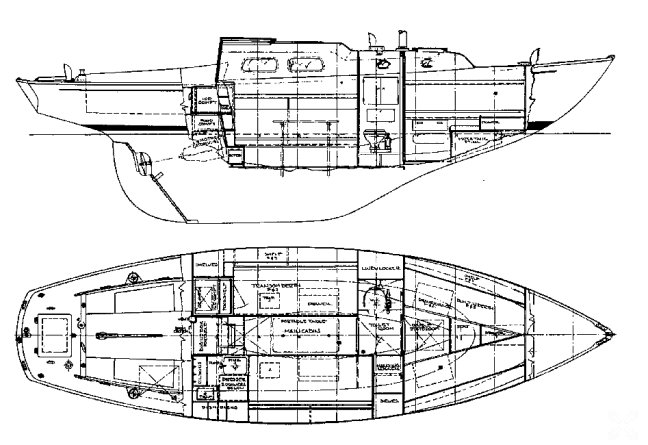 doesn't offer the huge waves and
winds that mid-ocean does. Also good trained assistance is usually
just a cell-phone call away (if you should happen to need it).
doesn't offer the huge waves and
winds that mid-ocean does. Also good trained assistance is usually
just a cell-phone call away (if you should happen to need it).
Pictured at left is a line drawing of an Alberg 30, a
typical Carl Alberg design. Pearson Yachts produced the first production
fiberglass sailboats. The fiberglass Pearsons were designed by Carl Alberg. They
sold well and made Pearson the #1 sailboat producer in the world for many years.
Click here for my
humble views on Alberg designs.
Listed below, in no particular
order, are a few sailboat spec sheets.
I've owned some of these boats, sailed on most of them...
Sailboats are the ultimate of personal preference. They evolve
slowly. Many of these boats have safely sailed on every ocean in
the world. I'll list the line drawings and specs on a few boats.
I'll also comment on a few of the designs
Click here for my views on Catalina 27s and
30s. These were two of my favorite
sailboats. However, there were actually three of them. The Catalina 27 has had
a major re-design since it was first introduced in 1971. The
original 27 ceased production in 1991. Total production was 6662 hulls.
The current model, the Catalina 270, debued in the fall of 1992. This is
why the Catalina 27 is not the longest production run of any
sailboat over 25 feet in length over all
(LOA).
I was forced to reduce the size
of this page, since many users with slower modems couldn't load it.
So click above for my views on these 3
sailboats.
Cal 2-27
The Cal 2-27 was designed by Bill Lapworth. The boat was a major
competitor to Frank Butler and his Catalina 27s during the 70s and
80s. Actually, I think that the Cal 2-27 is a little faster than
the Catalina 27, having a taller stick, more sail, a harder turn at
the bilges and a slightly flatter bottom.
The Cal's interior was not as nice as the Catalina. Frank
Butler, of Catalina, seemed more concerned with the creature
comforts of the interior and exterior of his 27 while Bill Lapworth
seemed more concerned with the performance end of sailing. People
seem to buy boats more for the creature-comforts. Note that
Catalina Yachts is alive and well while Cal Yachts is gone... I've
owned both boats, crewed on both. Matter of fact, I own a 1974 Cal
2-27 right now.
Here's some things I like better on the Cal. The lead keel was
bolted directly to the bottom of the hull on the Catalina but
Lapworth includes a fiberglass skeg (about 14 inches) into the
bottom of his hull and bolts the external lead ballast on the the
bottom of the skeg. This puts the ballast weight much lower in the
Cal. The turn at the bilges is a bit harder on the Cal, making it
initially stiffer and providing more interior room at the cabin
sole. Here are the specs for the Cal 2-27.
- LOA = 26' 7"
- LWL = 22' 1"
- Beam = 9' 4"
- Draft (fin keel) = 4' 6"
- Ballast (fin keel) = 3100 pounds
- Displacement Fin = 6700 pounds
- Engine = Inboard gas
- Sail area = 371 Sq. Ft
- I=36', J=12', P=30' 8", E=12' 3"
- Designer = Bill Lapworth /UL
I don't display a line drawing here of the Cal 2-27, since I
included several 2-27 line drawings in my "Sailing Old
Cal Yachts" page . The Cal is larger and heavier than
the Pearson 26 and the keel and rudder are not swept back as much.
Line drawings of the Cal 2-27 as well as several photos of my 2-27
"imp" can be seen on my Cal 2-27 page. The 2-27 page can be
accessed from my Cal Yachts webpage in the links near the bottom of
the page.
I've owned only 6 sailboats. I started sailing during the early
'70's with a used 14 foot Ray Green Rascal, then a McGregor Venture
21, then bought a used 1974 Catalina 27, sailed the Catalina for 9
or 10 years, bought a new 1983 Irwin Citation 34. I sold the 34 in
1989 and bought a used 1974 Cal 2-27. For my sailing in Lake Erie
and Lake Huron, I liked the 27 foot length. A 27 is easy to
maintain, has enough sail area to sail well but the sails aren't
too large for one person to handle. Not that I enjoy single handing,
I mostly sail with my wife but generally she has the helm and I do
the sails. Even though I like a 27 for ease of maintenance, I'm now
in the process of building a Bruce Roberts 35A from mild steel.
As far as sailing, I like the Cal better than the Catalina. The
'74 Catalina had a much nicer interior, however. Catalina Yachts
redesigned the 27 sometime between 1974 and 1996. It's interesting
how they leaned toward the Lapworth designed Cal 27 in this
redesign. They increased the beam, draft and waterline length. They
also lightened the boat like all the builders of today's era.
Myself, I don't mind the extra hull weight. I cruise mostly and
usually have the boat loaded fairly heavy anyhow.
Pearson
30
The Pearson 30 was a true big brother
to the 26. This model was produced by Pearson Yachts for about 9
years, from 1971 to 1980.
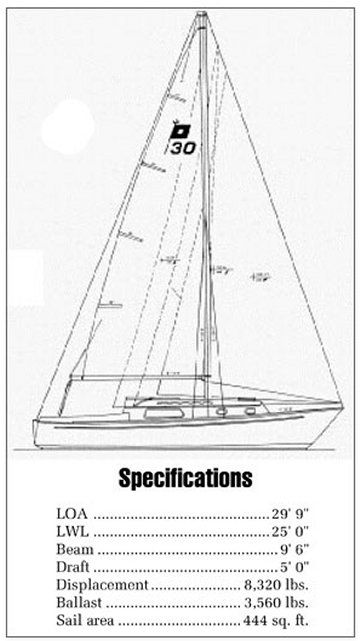 Vessel Walk Through . . . Starting forward there is a chain
locker followed by a large v-berth. Next aft is the head to port
and the sink for the head to starboard. Next aft is the main salon
with settees to starboard and port. On the port bulkhead is a fold
up table which drops down to make a very nice dinette. Next aft to
starboard is the galley area with counter and sink with an icebox.
Across from the galley is a comfortable port quarter berth.Cockpit
cushions were standard equipment. Vessel Walk Through . . . Starting forward there is a chain
locker followed by a large v-berth. Next aft is the head to port
and the sink for the head to starboard. Next aft is the main salon
with settees to starboard and port. On the port bulkhead is a fold
up table which drops down to make a very nice dinette. Next aft to
starboard is the galley area with counter and sink with an icebox.
Across from the galley is a comfortable port quarter berth.Cockpit
cushions were standard equipment.
These Pearsons, both the 26 and the 30, are small, by today's
standards. The actual size
of this 30 footer is not much larger than the new style Catalina 27 (page
up for specs on the Catalina 27). However, the hull weight and the weight of the
ballast is heavier in these old Pearsons. Myself, I'll still take the layer
after layer of heavy fiberglass over the new, high tech, lightweight
layups. Ballast = 3560 pounds external lead,
Bridge clearance =
42' 4"
Practical Sailor called this boat "a successful design that's
good for both club racing and short-term cruising. A good
investment." We agree. The 30 came with a Universal Atomic 4
gasoline inboard as and a full equipped galley as standard
equipment. These old Pearsons were built like Sherman Tanks.
They're a good, inexpensive purchase for first-time
sailors. 1973 to 1978 Pearson 30s can be purchased on
today's (May 2010) used boat market from about $7000
to $15000. A used Catalina 27 (1996 - 2010) is running
from about $35,000 to $55,000. As with all purchases of used
sailboats, a good marine survey is recommended.
Crealock 34
Pacific Seacraft builds a top of the line craft. The glass hulls
are sometimes several inches thick under the waterline. Interiors
are beautiful and immaculate. The long overhangs don't help it
conform to any racing rules but she'll ride better in a heavy chop.
This boat is my #1 choice in a "cruise the world" sailboat but, to
tell the truth, I can't afford one. If I could, I would have one...
Note that this boat is 2000 pounds heavier than my Irwin Citation
34 even though it's over a foot narrower and more than a foot
shorter on the waterline. Again, I'll take the extra weight! In all
fairness, my Irwin would probably whip this Crealock, boat for
boat, in most any weather but as I near the 60 year mark, this
doesn't seem as important as it did 30 years ago. A 20 foot Sea Ray
would whip 'em both!
- Length: 34 ft. 1 in. / 10.40 meters LOA
- LWL: 26 ft. 3 in.
- Beam: 10 ft. 0 inches / 3.05 meters
- Draft: 4 ft. 11 in. deep or 4 ft. 1 in. shoal
(Scheel)
- Displacement: 13,500 lbs. / 6,135 kg
- Sail Area: Sloop 534 sq. ft.
- Hull: FRP (Fiberglass)
- Spars: Aluminum
- Fuel: Diesel,
- Head: Standard
- Galley. 3-burner, oven
- Water: Not stated
- Designer: WIB (Bill) Crealock

The line drawing of this Crealock 34 is very similar to the line
drawing of the Crealock 37 below. Only the specs differ.
Crealock
37
- Length: 36 ft. 11 in. LOA ,27 ft. 9 in. LWL,
Beam: 10 ft. 10 in.
- Draft: 5 ft. 4 in., Displacement: 16,000 lbs.
- Sail area: Sloop 619 sq. ft.
- Sloop Main, 272 sq. ft.. 100% foretriangle, 347 sq.
ft.
- Hull: FRP (Fiberglass), Spars: Aluminum, Berths: 7
- Engine: 32 HP, Fuel: Diesel, 47 gals.
- Head: Standard, Galley. 3-burner, oven, Water: Not stated
- Rating: PHRF 174, Designer: WIB (Bill) Crealock
This sailboat may be seen in either sloop, cutter, or yawl, so
hull shape is important for identification. It has a very
distinctive stern. Long spoon bow with chin. Two-and-three porthole
layouts are also available. Underwater lines show a very normal fin
keel, but the canoe stern is unusual. The cutter rig shown does not
indicate staysails. Maximum beam is aft. Below, the main saloon
appears spacious. A double berth is to starboard, a single to port.
There is unusual storage in the fo'c'sle, with five drawers, a
hanging locker, and a vanity to port, and three drawers under the
double berth. The head has a grating over the shower drain. Aft is
a navigation station, seat, and double quarter berth. The galley is
to starboard and has three burners, a double sink, top-loaded
refrigerator, and oven. The cockpit has three seat lockers, and
there is a transom locker. Two skylights are over the forecabin and
the saloon. A short jib track, a traveler, and three winches are
mounted on the coach roof. A genoa track is mounted on deck
inboard, with leads to two primary cockpit winches. There is
pedestal-wheel steering.
 Irwin Citation 34 Irwin Citation 34
I owned a 1983 Irwin Citation 34 for 6 years. The boat was a
shoal draft, centerboard model. The boat sailed decently and had a
beautiful interior. The first year that I owned the boat, I was
beating back to Port Clinton, Ohio from Scudder's Wharf on Pelee
Island. This trip is about 30 miles as the crow flies. We were hard
on the wind, leeward rail kissing the water, centerboard down,
pounding hard against the famous 4 and 5 foot Lake Erie chop when
my wife called from below. "Come down here, it sounds like this
boat is breaking apart!" I went below and noticed the hull was
oilcanning (hull flexing) badly to the point that the flexing had
torn the cabin sole loose. I had sailed my 1974
Catalina 27 in the same conditions and never heard noises like
this. I went topside, reduced sail to ease the pounding. We
continued our trip to Port Clinton and arrived safely.
An inspection after our arrival showed that most of the
stainless steel screws that held the 3/4 inch plywood sole in place
had been torn loose from the hull's structural framework system. I
called Irwin Yachts and talked to an employee who told me that the
flexing was normal and to refasten the cabin sole with a size
larger screws. He said that the complete hull/structural
framework/sole assembly were built of high tech plastics and were
strong only as a unit. I refastened the sole as he told me but also
doubled the number of screws. I never had any more trouble but
always worried about the boat's hull strength. I never pushed the
boat hard after that. I sold her in 1989.
I've said this before and I'll say it again. "Maybe "high tech"
is OK but give me the old, heavy, layer after layer of glass matt
and roving." It makes for a heavier boat but sure does make me feel
better. I've heard stories about other designs (good, expensive
designs) that would oilcan in certain conditions. Perhaps I worry
too much... My Irwin never let me down, always sailed well, but
that beat back from Pelee always stayed on my mind.
- Length: 34 ft. 7 in.
- LWL: 27 ft. 4 in.
- Beam: 11 ft. 3 inches
- Draft: 5 ft 4 in (deep) 4 ft. even (shoal)
- Displacement: 11,500 lbs.
- Sail area: 582 Sq. ft.
- Hull: FRP (Fiberglass)
- Spars: Aluminum
- Fuel: Diesel,
- Head: Standard
- Galley. 3-burner, oven
- Water: 80 gallon
- Designer: Ted Irwin
I included the Irwin here because Karen and I did like the boat.
It was a little tender but sailed very well. The Yanmar 3 cylinder
diesel always performed perfectly. The helm was easy to handle even
in strong blows. The galley and the interior were beautiful. We
enjoyed the shallow draft and the centerboard really helped on the
windward legs. When pushing the boat to windward, weather helm
could be reduced quickly by simply cranking the centerboard up
about halfway, moving the keel's lifting effort aft (also letting
the boat slide a little more). This always kept Karen happy on the
helm until I could shorten up the main. After a reef or two were
tucked into the main, the centerboard could be lowered fully
again.
Valiant 40 by Robert Perry.
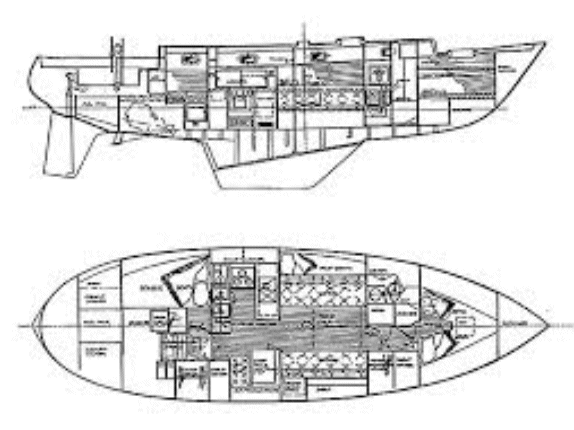
The Valiant 40 was the first boat
designed by naval architect Robert Perry, it was introduced in 1973. The success
of several Valiant 40s competing in long ocean races during the early 1980s
brought this boat to the notice of the world sailing community.
Draft of 6 feet is a little deep for our sailing in
eastern Lake Erie and the east coast of the U.S.. I
admit, I'm a gunkholer. However, I think that the
Valiant 40 is available in a shoal draft version now.
LOA . . 39’ 10 3/4"
LWL . . . 34’ 0"
Maximum Beam 12’ 4"
Maximum Draft 6’ 0"
Displacement/Weight 22,500 lbs
Fuel Capacity 95 Gallons
Water Capacity 120 Gallons
Bruce Roberts 35 A (aft cockpit) from mild steel.
This boat is my ultimate offshore cruiser. Mild steel, long fin
keel, skeg mounted rudder. Note the similarity of this design to
the Crealock 34 and 37 shown above. I am finishing one of these in
my back yard at this time. The hull, deck, mast, rigging, and
engine are completed. I'm now working on the interior.
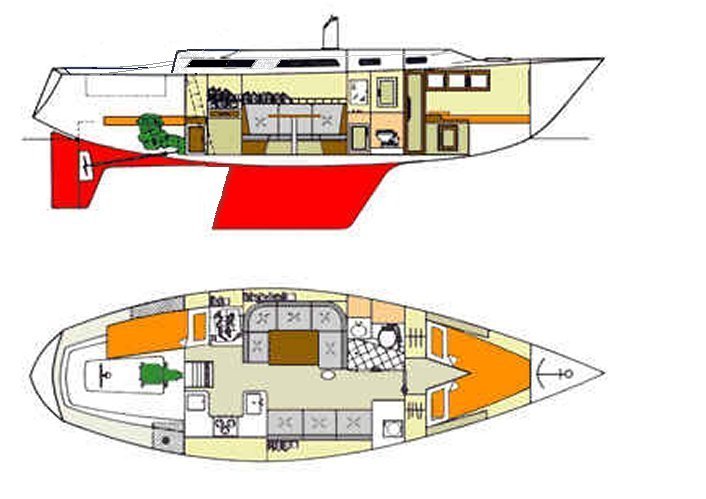 As you can see by the line drawing on the
right, I've extended the back of the cabintop by 14 inches. This
shortens the cockpit but adds interior space to the main salon. The
cockpit is still long enough fo a large person to take a
comfortable nap. As you can see by the line drawing on the
right, I've extended the back of the cabintop by 14 inches. This
shortens the cockpit but adds interior space to the main salon. The
cockpit is still long enough fo a large person to take a
comfortable nap.
This style of hull has tremendous strength and the fin keel
offers good windward ability. The steel hull will absorb shock and
bend with impact where fiberglass would crush and tear. This makes
me feel much better when sailing at night when it's possible to hit
a partially submerged object such as a floating log.
- Length: 35 ft. 6 in. LOA
- LWL: 27 feet 6 inches
- Beam: 11 ft. 0 inches
- Draft: 5 ft. 6 in.
- Displacement: 13,200 lbs.
- Hull: Mild Steel
- Spars: Aluminum
- Engine: Inboard
- Head: Standard
- Galley. 3-burner, oven
- Designer: Bruce Roberts
This hull/deck is now for
sale. SOLD! 08/07/2010
The hull, deck, is complete, an Atomic 4 inboard
engine is installed. The interior is not completed. I'm now 71 years old
and would love to see someone finish it. I could make you a
deal that couldn't be refused. I would sell this completed
steel hull/deck for less than today's cost of
the steel plate. If someone wants a boat building project,
this would be a good one. The boat needs TLC but is solidly
MIG welded steel for world cruising safety. Just email me at the
bottom of most of my pages at
go2erie@sssnet.com . Please put "Roberts 35 question" as the
subject so that I don't miss your email.
I said earlier that most of these boats have sailed every ocean
in the world, and they have. Myself, I prefer a skeg mounted rudder
on any boat that I take offshore. A skeg mounted rudder will take a
lot more pounding than a spade. When a spade rudder breaks, it is
usually gone. This makes it hard to jury rig. I know, spade rudders
have circled the world, many times singlehanded. Still, offshore,
give me a steel hull and deck and a skeg mounted rudder (see the
Roberts 34 above).
I was in an offshore storm. We were in an Endeavor 37, heading
from Nassau thru the Tongue of the Ocean, to Chub Cay. The blow
lasted more than 30 hours. We were lucky and finally managed to
make shelter behind Whale Cay, a small horseshoe shaped island.
Others were not so lucky.
Even back then, when I was younger and carefree, I
worried about the boat's hull. We had an Avon life raft but getting it inflated
and everyone into it is something I don't even want to think about. Now, 33
years later, maybe the storm wasn't as bad as I thought. But also, even now, I
know that a hull, deck or rudder failure would have been catastrophic. But
all went well, the only major damage was a torn mainsail. For this
reason an Endeavor 37 will be included in this review. That Endeavor took
a terrific pounding during that blow and never even whimpered. 
This, of course, is a snapshot of my present boat, still
under construction. She's a hearty ol girl, with most of the modern conveniences
of home. The path, of course, leads to the outdoor head. All she needs is a good
coat of paint and she'll be ready for a world cruise. As you can see by the
photo, I have already started setting sail. I'll be ready when the tide comes
in.
e-mail me a comment about this page.
go2erie@sssnet.com
This page was last
modified on 9/16/2014.
|

![]()
![]()
![]()
![]()
![]()
![]()
![]()
![]()
 I wouldn't sail
around the world in a Catalina 27 but many sailors have. At least
one person has actually singlehanded a Catalina 27 around the
world. My reply to this: "several people have gone over Niagara
Falls in a barrel but I'm not going to do it." That same person
that went over the falls in a barrel will probably single hand a Catalina 27 around the world.
I place the comfort rate in both about the same. Actually, here in the Great Lakes,
I enjoy a 27 foot sailboat.
I wouldn't sail
around the world in a Catalina 27 but many sailors have. At least
one person has actually singlehanded a Catalina 27 around the
world. My reply to this: "several people have gone over Niagara
Falls in a barrel but I'm not going to do it." That same person
that went over the falls in a barrel will probably single hand a Catalina 27 around the world.
I place the comfort rate in both about the same. Actually, here in the Great Lakes,
I enjoy a 27 foot sailboat.
 doesn't offer the huge waves and
winds that mid-ocean does. Also good trained assistance is usually
just a cell-phone call away (if you should happen to need it).
doesn't offer the huge waves and
winds that mid-ocean does. Also good trained assistance is usually
just a cell-phone call away (if you should happen to need it). Vessel Walk Through . . . Starting forward there is a chain
locker followed by a large v-berth. Next aft is the head to port
and the sink for the head to starboard. Next aft is the main salon
with settees to starboard and port. On the port bulkhead is a fold
up table which drops down to make a very nice dinette. Next aft to
starboard is the galley area with counter and sink with an icebox.
Across from the galley is a comfortable port quarter berth.Cockpit
cushions were standard equipment.
Vessel Walk Through . . . Starting forward there is a chain
locker followed by a large v-berth. Next aft is the head to port
and the sink for the head to starboard. Next aft is the main salon
with settees to starboard and port. On the port bulkhead is a fold
up table which drops down to make a very nice dinette. Next aft to
starboard is the galley area with counter and sink with an icebox.
Across from the galley is a comfortable port quarter berth.Cockpit
cushions were standard equipment.

 As you can see by the line drawing on the
right, I've extended the back of the cabintop by 14 inches. This
shortens the cockpit but adds interior space to the main salon. The
cockpit is still long enough fo a large person to take a
comfortable nap.
As you can see by the line drawing on the
right, I've extended the back of the cabintop by 14 inches. This
shortens the cockpit but adds interior space to the main salon. The
cockpit is still long enough fo a large person to take a
comfortable nap.
